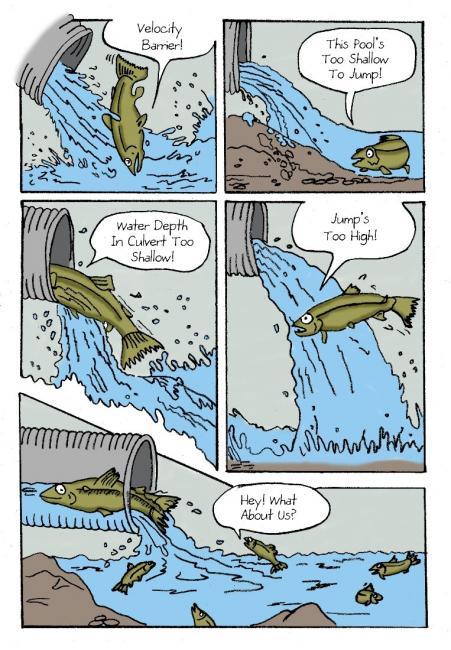Improving fish passage
Learn about fish passage barriers and why we fix them.
Fish barriers
A fish passage barrier is anything that hinders fish from moving upstream or downstream. Culverts, large pipes under roadways, allow water to flow but may not allow fish to swim through. Culverts may block fish migration because the water flow is too swift, too shallow, or has a waterfall into or out of the culvert.

We correct fish barriers on state highways to help salmon recovery and comply with state laws. Since we created a dedicated fish passage program in 1991, we have corrected hundreds of barriers that have restored access to over one thousand miles of fish habitat. In addition to our ongoing work to correct statewide barriers, a 2013 federal court injunction requires the state to correct barrier culverts to salmon and steelhead within the injunction area in western Washington.
Opening habitat allows more salmon and steelhead at all life stages (including juveniles who aren’t yet strong swimmers like adults) to access important spawning and rearing habitat, including areas that have been inaccessible for years. Installing structures like bridges and culverts that allow for natural stream processes help protect and restore salmon runs, ultimately benefiting both the Pacific Northwest landscape and economy.
For more information on corrected and uncorrected barriers and the injunction boundary, use our interactive map to learn more.
The importance of salmon and steelhead recovery
Salmon and steelhead are important members of our ecosystems. They:
- Provide an important food source for over 100 species of wildlife, including orca whales.
- Contribute to Washington’s economy through recreational and commercial fishing.
- Support an estimated 16,000 jobs and over $500 million in personal income alone.
- Create jobs and benefit local economies through habitat restoration work.
- Have cultural importance to the many tribes who rely on salmon and steelhead as a food source. Washington State must uphold treaty-reserved fishing rights, ensuring that salmon are present and available for harvest.
How culverts become barriers
Most of our culverts were installed decades before the needs of fish were fully understood. We met requirements for culvert installation and sizing according to construction standards at the time. However, a culvert that was fish passable at the time of installation might have become a barrier over time due to changes in the landscape and stream flows resulting from development, logging, and fire. The new fish-friendly structures we construct now are larger, more resilient to changes in the landscape, and provide fish passage long into the future.
Benefits to removing barriers
A single removed barrier can deliver impressive benefits by improving fish access for miles both upstream and downstream. When rivers and streams reconnect, fish can better access the habitat they need to reproduce, access food resources, escape predators, and find refuge from high winter stream flows. This important component of protecting and restoring fish populations can have multiple benefits, especially for commercial and recreational fishing industries.
Learn how we work with our partners to help restore salmon runs and see results from recent fish passage projects in our fish passage restoration at WSDOT video.
Slow down – lives are on the line.
In 2023, speeding continued to be a top reason for work zone crashes.
Even one life lost is too many.
Fatal work zone crashes doubled in 2023 - Washington had 10 fatal work zone crashes on state roads.
It's in EVERYONE’S best interest.
95% of people hurt in work zones are drivers, their passengers or passing pedestrians, not just our road crews.
